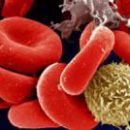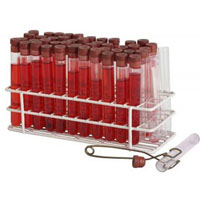Hemolytic disease in reserves conflict - a dangerous disease. The process of occurrence of the disease is simple: during pregnancy through the placenta from the fetus to the mother penetrate the antigens penetrate. In response to this maternal blood produces rhesus antibodies to destroy the reserves-positive erythrocytes of the fetus.
Content
Hemolytic fruit disease
 Finding into the bloodstream of the fetus, immune rhesus antibodies react with its rhesus-positive erythrocytes (reaction «Antigen - antibody»), as a result, the destruction (hemolysis) of red blood cells occurs and hemolytic fruit disease is developing (GBN). The destruction of erythrocytes leads to the development of anemia (decrease in the amount of hemoglobin) in the fetus, as well as damage to its kidney and brain. Since red blood cells are continuously destroyed, the liver and spleen of the fetus try to accelerate the production of new red blood cells, while increasing in size.
Finding into the bloodstream of the fetus, immune rhesus antibodies react with its rhesus-positive erythrocytes (reaction «Antigen - antibody»), as a result, the destruction (hemolysis) of red blood cells occurs and hemolytic fruit disease is developing (GBN). The destruction of erythrocytes leads to the development of anemia (decrease in the amount of hemoglobin) in the fetus, as well as damage to its kidney and brain. Since red blood cells are continuously destroyed, the liver and spleen of the fetus try to accelerate the production of new red blood cells, while increasing in size.
The main manifestations of the hemolytic disease of the fetus are an increase in liver and spleen, an increase in the number of accumulating water, the thickening of the placenta. All these signs are detected by ultrasound during pregnancy.
In the hardest cases, when the liver and spleen do not cope with the load, strong oxygen starvation occurs, hemolytic disease leads to the intrauterine death of the fetus at various times of pregnancy. Most often, the rhesus conflict manifests itself after the birth of a child, which contributes to the receipt of a large number of antibodies in the infant blood when violating the integrity of the placenta vessels. Hemolytic disease is manifested by anemia and jaundice newborns.
Depending on the severity of hemolytic disease distinguish between its forms.
Anemic form
Anemic form This is the most benign option for the flow of hemolytic disease of the newborn. Manifests itself immediately after birth or during the 1st week of life anemia with which the patenity of the skin is connected. The size of the liver and spleen increases, there are minor changes in the results of analyzes. The overall condition of the baby is disturbed by little, the outcome of such a disease is favorable.
Yellowed form
The jaundice form is the most common middleweight form of a newborn hemolytic disease. Its main manifestations are early jaundice, anemia and an increase in the size of the liver and spleen. The state of the baby worsens as the product of the decay of hemoglobin - bilirubin: the crumb becomes sluggish, drowned, he is oppressed by physiological reflexes, the muscular tone is reduced. On the 3rd - 4th day without treatment, the level of bilirubin can reach critical figures, and then the appearance of symptoms of nuclear jaundice is possible: the rigidity of the occipital muscles, when the baby cannot tilt his head forward (attempts to bring chin to the chest unsuccessful, they are accompanied by crying), convulsions, Wide open eyes shrill. By the end of the 1st week, the stagnation syndrome of boles can develop: the skin becomes a greenish tint, the feces are blewing, the urine darkens, the content of the associated bilirubin increases in the blood. The jaundice form of the GBN is accompanied by anemia.
Emirates
Elemental form - the most severe measure of the disease. In the early development of the immunological conflict, miscarriage may occur. Under the progression of the disease, the massive intricatular hemolysis - the collapse of the erythrocytes - leads to severe anemia, hypoxia (oxygen deficiency), metabolic disorders, decrease in the level of proteins in the bloodstream and tissue edema. Fruit is born in extremely serious condition. Fabrics Even, in body cavities (chest, abdominal) liquid accumulates. Leather sharply pale, glossy, jaundice expressed weakly. Such newborns sluggish, muscular tone have sharply reduced, reflexes are depressed.
Liver and spleen are significantly increased, the stomach is big. Cardiovary Lady expressed.









